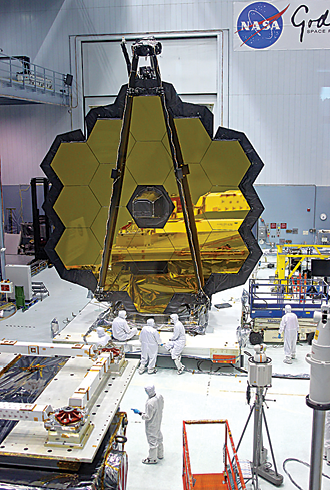Although the James Webb Space Telescope isn’t scheduled to be launched on an Ariane 5 rocket from French Guiana until October 2018, NASA announced that the 18th and final primary mirror segment was recently installed on what will be the biggest and most powerful space telescope. Each segment required almost a year to process, including 6,600 hours of machining time, heat treatment and inspection. The infrared telescope has a 6.5m (21.3') primary mirror and a 0.74m-dia. (2.4') secondary mirror, and, compared to 2.4m-dia. (7.9') Hubble Space Telescope, the JWST will have nearly three times higher resolution in the infrared.

Technicians perform optical tests on the James Webb Space Telescope. Image courtesy NASA.
The stated mission goals of the JWST are to:
- Search for the first galaxies or luminous objects formed after the big bang;
- determine how galaxies evolved from their formation;
- observe the formation of stars from the first stages of the formation of planetary systems; and
- measure the physical and chemical properties of planetary systems and investigate the potential for life in those systems.
The mirror segments are made of ultralightweight beryllium and will unfold and adjust to shape after launch, NASA reported. Each hexagonal-shaped segment measures about 1.3m (4.2') across and weighs about 40kg (88 lbs.). Once polishing is completed for each segment, a 100nm-thick coating of gold is applied via vacuum vapor deposition to improve the mirror’s ability to reflect infrared light. About 3g (0.106 oz.) of pure gold, total, is deposited on the mirrors.
As reported in CTE’s May 2007 issue shortly after Axsys Technologies Inc., Cullman, Ala., completed production of the mirror segments, Axsys purchased eight Model HS6A horizontal machining centers from Mitsui Seiki USA Inc., Franklin Lakes, N.J., to machine the segments.
According to the machine tool builder, machining began when a 540-lb. (245kg) beryllium billet was fixtured vertically onto an angle plate on one of the machines. The six-sided billet was 4" (101.6mm) thick, 54" (1,371.6mm) across and 62" (1,574.8mm) from point to point. The reverse side of each mirror segment has 600 2.5"-square (63.5mm) pockets. There are also 22 mounting pads and 249 lightweighting holes. Producing the pockets, pads and holes took about 2 months to complete.
After pocket milling on the reverse side, a billet weighed about 275 lbs. (125kg), Mitsui Seiki said. The segment was heat-treated to relieve machining stresses and then the mirror side was roughed before another heat treatment. Roughing followed a circular path that started in the center and worked outward, removing another 50 to 60 lbs. (22.7kg to 27.2kg) of material. Next, the pocket side was finish-milled during a 10-week process.
After finish and chemical milling, the pocket wall measures from 0.020" to 0.299" (0.508mm to 7.595mm) thick. The mirror surface itself has a specified thickness of 0.098" (2.489mm). The final machining operation was for (30) 0.250"-dia. (6.35mm) holes and slots on the edge; a tolerance of +0.0002"/-0.00" (0.0051mm) was specified. Tooling balls were placed in these holes for reference purposes during mirror polishing.
Related Glossary Terms
- angle plate
angle plate
Solid adjustable or nonadjustable plate that holds work at a precise angle to the spindle during machining. Also used for inspection.
- centers
centers
Cone-shaped pins that support a workpiece by one or two ends during machining. The centers fit into holes drilled in the workpiece ends. Centers that turn with the workpiece are called “live” centers; those that do not are called “dead” centers.
- gang cutting ( milling)
gang cutting ( milling)
Machining with several cutters mounted on a single arbor, generally for simultaneous cutting.
- milling
milling
Machining operation in which metal or other material is removed by applying power to a rotating cutter. In vertical milling, the cutting tool is mounted vertically on the spindle. In horizontal milling, the cutting tool is mounted horizontally, either directly on the spindle or on an arbor. Horizontal milling is further broken down into conventional milling, where the cutter rotates opposite the direction of feed, or “up” into the workpiece; and climb milling, where the cutter rotates in the direction of feed, or “down” into the workpiece. Milling operations include plane or surface milling, endmilling, facemilling, angle milling, form milling and profiling.
- polishing
polishing
Abrasive process that improves surface finish and blends contours. Abrasive particles attached to a flexible backing abrade the workpiece.
- tolerance
tolerance
Minimum and maximum amount a workpiece dimension is allowed to vary from a set standard and still be acceptable.

